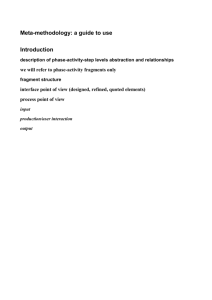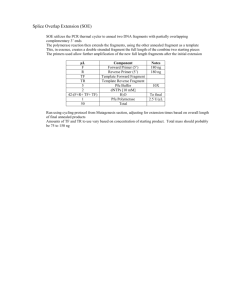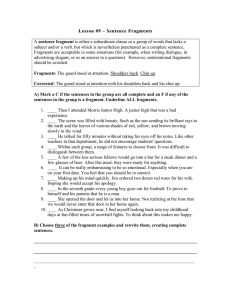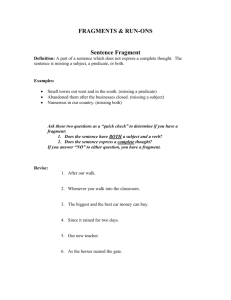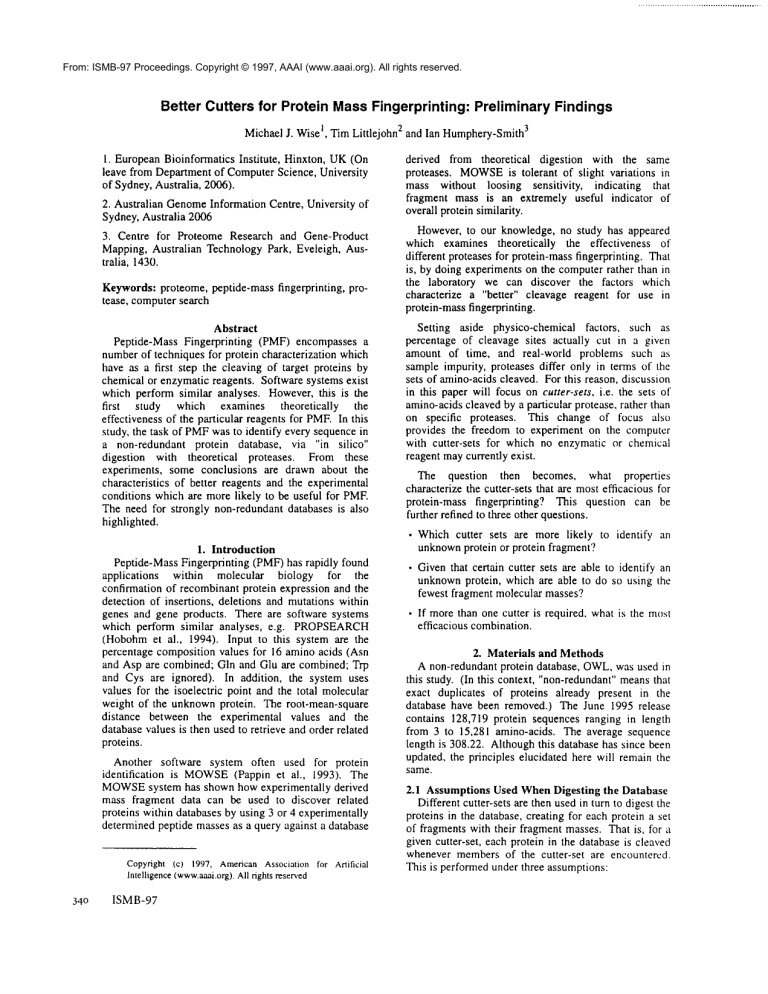
From: ISMB-97 Proceedings. Copyright © 1997, AAAI (www.aaai.org). All rights reserved.
Better Cuttersfor Protein MassFingerprinting:PreliminaryFindings
Michael J. WiseI, Tim Littlejohn 2 3and Ian Humphery-Smith
1. European Bioinformatics Institute, Hinxton, UK(On
leave from Department of ComputerScience, University
of Sydney, Australia, 2006).
2. Australian GenomeInformation Centre, University of
Sydney, Australia 2006
3. Centre for Proteome Research and Gene-Product
Mapping, Australian Technology Park, Eveleigh, Australia, 1430.
Keywords:proteome, peptide-mass fingerprinting,
tease, computersearch
pro-
Abstract
Peptide-Mass Fingerprinting (PMF) encompasses
numberof techniques for protein characterization which
have as a first step the cleaving of target proteins by
chemical or enzymatic reagents. Software systems exist
which perform similar analyses. However, this is the
first
study which examines theoretically
the
effectiveness of the particular reagents for PMF.In this
study, the task of PMFwas to identify every sequence in
a non-redundant protein database, via "in silico"
digestion with theoretical
proteases. From these
experiments, some conclusions are drawn about the
characteristics of better reagents and the experimental
conditions which are more likely to be useful for PMF.
The need for strongly non-redundant databases is also
highlighted.
1. Introduction
Peptide-Mass Fingerprinting (PMF)has rapidly found
applications
within molecular biology for the
confirmation of recombinant protein expression and the
detection of insertions, deletions and mutations within
genes and gene products. There are software systems
which perform similar analyses, e.g. PROPSEARCH
(Hobohmet al., 1994). Input to this system are the
percentage composition values for 16 amino acids (Asn
and Asp are combined; Gin and Glu are combined; Trp
and Cys are ignored). In addition, the system uses
values for the isoelectric point and the total molecular
weight of the unknownprotein. The root-mean-square
distance between the experimental values and the
database values is then used to retrieve and order related
proteins.
Another software system often used for protein
identification
is MOWSE
(Pappin et al., 1993). The
MOWSE
system has shown how experimentally derived
mass fragment data can be used to discover related
proteins within databases by using 3 or 4 experimentally
determined peptide masses as a query against a database
Copyright(c) 1997. AmericanAssociationfor Arlificial
Intelligence
(www.aaai.org).
All rights reserved
34o
ISMB-97
derived from theoretical
digestion with the same
proteases. MOWSE
is tolerant of slight variations in
mass without loosing sensitivity,
indicating that
fragment mass is an extremely useful indicator of
overall protein similarity.
However, to our knowledge, no study has appeared
which examines theoretically
the effectiveness of
different proteases for protein-mass fingerprinting. That
is, by doing experiments on the computerrather than in
the laboratory we can discover the factors which
characterize a "better" cleavage reagent for use in
protein-mass fingerprinting.
Setting aside physico-chemical factors, such as
percentage of cleavage sites actually cut in a given
amount of time, and real-world problems such as
sample impurity, proteases differ only in terms ot" the
sets of amino-acids cleaved. For this reason, discussion
in this paper will focus on cutter-sets, i.e. the sets of
amino-acidscleaved by a particular protease, rather than
on specific proteases. This change of focus also
provides the freedom to experiment on the computer
with cutter-sets for which no enzymatic or chemical
reagent maycurrently exist.
The question then becomes, what properties
characterize the cutter-sets that are most efficacious for
protein-mass fingerprinting?
This question can be
further refined to three other questions.
¯ Which cutter sets are more likely to identify
unknownprotein or protein fragment’?
an
¯ Giventhat certain cutter sets are able to identify an
unknownprotein, which are able to do so using the
fewest fragment molecular masses?
¯ If more than one cutter is required, what is the most
efficacious combination.
2. Materials and Methods
A non-redundant protein database, OWL,was used in
this study. (In this context, "non-redundant"meansthat
exact duplicates of proteins already present in the
database have been removed.) The June 1995 release
contains 128,719 protein sequences ranging in length
from 3 to 15,281 amino-acids. The average sequence
length is 308.22. Althoughthis database has since been
updated, the principles elucidated here will remain the
same.
2.1 Assumptions Used When Digesting the Database
Different cutter-sets are then used in turn to digest the
proteins in the database, creating for each protein a set
of fragments with their fragment masses. That is, for a
given cutter-set, each protein in the database is cleaved
whenever membersof the cutter-set are encountered.
This is performed under three assumptions:
2.1.1 Cleavage is always perfect Under certain
circumstancescertain physical reagents fail to cleave as
expected, e.g. when faced with sequences composed of
of Phe, Trp or Tyr, chymotrypsin sometimes leaves one
or more bonds uncut. In practice, this can be overcome
by leaving the digestion to run longer.
2.1.2 Cleavage always occurs on the Carboxyl terminal
of an amino-acid While most enzymatic and chemical
reagents cleave on the C terminal, a number cleave on
the N terminal. However,to makea distinction in these
experiments would impart a bias (albeit a small one)
the statistics; fragments generated by N-terminal cutters
would be one amino-acid shorter than those generated
by C-terminal cutters.
2.1.3 Fragment masses are accurate to the nearest
Dalton (i.e. +/- 0.5 Da) While this degree of is often
not possible in practice nothing is lost by the added
precision; Theconstraint can be relaxed at a later stage,
after an appropriate windowsize has been determined
experimentally.
2.2 Excess Cutters
Whena particular cutter-set is applied to the database
excess cutters pose a special challenge. For example, if
the cutter set is E (Glu) and part of the current protein
is: . ..IRPPLRGQRPQEEEEEEGRHGRHG.,.
then the first
E will terminate the fragment ...IRPPLRGQRPQE.
The
question is what to do with the remaining 5 repetitions
of E - the excess cutters. Thereare three possibilities:
2.2.1 Single Cutters Assumingperfect digestion, each
of the excess cutters will form a tiny fragment
containing just that amino-acid. Unfortunately, because
excess cutters are relatively commonthere would be a
spike in the count of occurrences for that fragment-mass
whichwoulddistort the statistics.
2.2.2 No Single Cutters A second strategy is simply to
ignore any fragment containing a single amino-acid, or
alternatively,
knowing the molecular masses of the
cutters, to ignore fragments with those masses. This
strategy avoids the spike in the counts of occurrences.
2.2.3 Pseudo Fragments The third strategy is to
construct pseudo-fragments - sequences containing only
membersof the cutter-set. These sequences terminate
just before the first non-cutter. In the example above,
the first E terminates the previous fragment. The
remaining cutters form a pseudo-fragment of length 5.
Pseudo-fragmentshave the advantage that excess cutters
are treated in a manner similar to non-cutters thus
providing additional information about proteins which
would otherwise be lost.
2.3 Determining a Minimal Covering Set of
FragmentMasses for a Protein
A covering set for a particular protein is a subset of
the fragment masses, generated by a given cutter set,
which is sufficient to uniquely identify that sequence
from all the others in the database. For example,
fragment masses 1,440 and 3,545, though they appear in
other sequences, only appear together in sequence
1B46_HUMAN.
Moreover, in this case the covering set is
also minimal, i.e. there are no smaller sets of fragment
masses that uniquely identify this protein. However,of
greater interest is the averageminimumcovering set, i.e.
for all the sequences for which a minimumcovering set
can be found, this is the average size of the minimum
covering sets.
The algorithm for obtaining a guaranteed minimum
covering set for each protein (if one exists) can
shown to be NP-complete. Specifically, in Garey and
Johnson’s survey, (Garey & Johnson, 1979) the
minimumset cover problem is listed as NP-complete,
with the proof attributed to Karp. Here what is sought
is, for each sequence, the minimum number of
fragments such that, when the intersection of their
container-sets is taken, a singleton set is returned. That
is, each container-set generated by fragments in a
particular sequence must at least contain the identifier
for that sequence, so if a combination of fragments
uniquely identifies the sequence, the intersection of the
fragments’ container sets will return the singleton set
containing just that sequence’s identifier. (A containerset for a particular fragmentmassis the set of sequences
containing that mass.)
The following greedy algorithms were therefore used:
For each sequence in the database:
Sort the fragments in order of increasing containerset size. This will reveal those sequences which are
uniquely identified
by a single fragment. Uncut
sequences can also be dealt with immediately; either
their single fragment-massesare unique and identify the
sequence or they are shared and no solution is possible
(at least for that cutter-set).
All the container-sets are intersected. If the singleton
set does not result, no solution is possible for that
sequence. Onthe other hand, if a solution is found and
the solution involves two fragments, the algorithm can
stop because a minimalsolution has been found.
Thecontainer-sets are intersected pairwise. If a pair
of container-sets yields the singleton set, the algorithm
for that sequence stops. As mentioned above, any such
solutions are minimal.
If no solution is found for pairs of fragments, the
fragment-pair with the smallest container-set
intersection is then intersected with each of the
remaining fragments’ container sets. This process is
repeated until the singleton set results, retaining at each
pass the fragment whoseintersection with the current
combination produces in the greatest reduction in
resultant set size. If a singleton set results from the
intersection of 3 fragments, that solution must also be
minimal.
Solutions involving 4 or more fragments are not
necessarily minimal and can possibly be improved.
Two algorithms are used to attempt to improve these
solutions:
Each of the fragments’ container-sets are removedin
turn fromthe intersection. If the resulting intersection
remains unchanged (the singleton set), then that
fragmentis clearly not essential.
Wise
34x
The initial
fragment set is randomized and the
intersection of all the container sets is taken. The
number of fragments required for a covering-set is
returned.
The complexity of these algorithms is dominated by the
O(mn2) pairwise comparison of container sets, where n
is the length of the list of fragment molecular masses
(which in turn is proportional to the length of the input
sequences), and m is the length of the container-sets
being intersected at each step. Minimal covering sets
are typically
obtained for more than 99% of the
sequencesfor whicha covering set exists.
3. Experiments and Results
3.1 Comparing Excess Cutter Methods
To first
settle the choice of excess-cutter
methodology, three different cutter-sets: C, L and RK
were used to digest the protein database for each of the
three
possible
excess-cutter
methodologies.
Considering the sizes of the average minimumcovering
sets together with the numbersof unidentified sequences
it was noticeable that for each cutter, the choice of
methodfor dealing with excess cutters did not make a
great deal of difference. However, Pseudo-fragments
generally performed better than No-Single-Cutters,
which in turn was better than Single-Cutters. For this
on
reason, subsequent experiments standardized
Pseudo-fragments.
3.2 ComparingDifferent Cutter Sets
The database was then digested by cutter sets
containing the 20 naturally occurring amino-acids taken
singly, together with cutter sets corresponding to the
proteases Chymotrypsin (FWY), Trypsin (RK) and
C (ED). The Pseudo-fragments method was used
each experiment. The striking observation was that for
each of the cutter sets, the size of the average minimum
covering set was around 2.0. Furthermore, each of the
cutters left somesequences unidentified, ranging from
10,168 (FWY),10,598 (G) to 26,104 (W), 23,290
Regression analysis was carried out across the 23 sets
of measurements on the various metrics against the
Count of eligible fragments, the latter a measure of
whether the cutter-set contains common(i.e. frequent)
uncommoncutters. From this is was clear that cutter
sets which aim to reduce the number of unidentified
protein sequences will have the effect of increasing the
size of the covering sets (specifically
the minimum
covering sets), and vice versa.
3.3 Impact of Restricting the Rangeof Eligible
Fragments
The techniques currently in use for protein-mass
fingerprinting are unable to measure the large range of
fragment masses revealed by the computer-based
experiments. (The largest fragment, due to the cutter C,
had a mass of 639,522Da.) The next experiments
therefore examinedthe impact of restricting the range of
eligible fragment masses. Three ranges were chosen:
¯ 0 to Inf, i.e. open range
¯ 500 to 5,000 (reflecting the range of masses examined
342
ISMB-97
by manyprotein-mass fingerprinting systems)
¯ 0 to 5,000
The database was digested by the cutter sets C and RK
for each of the three fragment-mass size ranges. The
impact of restricting the range of eligible fragment
masses was particularly
evident on the counts of
unidentified
protein sequences. For RK, a common
cutter, removing the top of the range - from 5,000Da
upwards - had relatively little impact, increasing the
numberof unidentified proteins from 10,278 to 11,677.
On the other hand, further restricting the range by
removing the bottom of the range had a larger impact,
increasing the count from !1,677 to 17,581. In other
words, for a commoncutter, there would appear to be
muchuseful information in the range of masses below
500Da.
By contrast, an uncommoncutter such as C has most
of its useful information in the open-ended range of
masses above 5,000Da; when the top of the mass sizerange is removed the number of unidentified proteins
jumps from 22,909 to 62,616, while also removing the
bottom of the range only causes a small further increase,
to 66,720.
A subsequent experiment used a cutter set of RKand
a sliding mass-range-window of 500Da to see which
window contains the most information. The window
was advanced in increments of 50Da. That is,
increasing eligible-fragment-mass ranges where tried,
from 50-549, 100-599, 150-649, and so on to
3,000-3,499.
It was found that the number of
unidentified proteins falls initially, reaching a minimum
in the range 350-849 and then rises steadily. At the
same time, the size of the average minimumcovering
sets rises slightly at the outset reaching a peak of 3.39
for the window250-749and then falls steadily, reaching
a minimum of 0.22 in the last window sampled
(3,000- 3,499).
To understand why the smaller fragment masses are
so useful, the counts of the various masses were
examined for the cutter-set RK. What was noticeable
was the sharp peak on the counts in the range 500- 1,000
Da. In particular, although manymasses around 500Da
have very high incidences, manyothers are remarkably
uncommon.Thus, used either singly or in combination
with more commonmasses, they mayserve to identify a
sequence. Just as importantly, there are few gaps in the
range of fragment masses (i.e. masses for which no
fragment exists), particularly for masses between200Da
and 5,000Da. For fragment masses above 5,000Da,
incidences are typically low with large gaps in the range
of fragment masses. Therefore, particularly for the
common cutter RK and a fixed window size, the
probability of having a unique combination is actually
lessened above 5,000Da.
3.4 The Problem with Non-RedundantDatabases
Knowingnow that each cutter-set leaves a number of
sequences unidentified, the question became: will a
combination of cutter-sets be able to identify all the
sequences in the database’? The methodology would be
identical to that employed for fragments within
sequences:test (in linear time) that a solution is possible
by taking the intersection of all the sets of unidentified
sequences; the empty set implies that a solution is
possible. The next step would then be to find the
smallest such combination.
Whenthe intersection of all 23 cutter sets was taken,
899 sequences remained unidentified.
A closer
examination of the 899 sequences reveals that:
¯ The smallest are 3 sequences of length 3; 656 (73%)
sequences contain 15 amino-acids or less, and 744
(83%) contain 20 amino-acids or less. (The median
value is I 1, with the modeat 10.)
¯ Of the remainder, particularly the 167 sequences with
20 or more amino acids, many are more than 90%
similar to others in the group. (Many of these
matches are greater than 97%.)
¯ One unusually long sequence, HUMCR1SF41,
2037 aa,
appears in the list of unidentified
sequences.
However, looking at the complete database one finds
a sequence HUIdCR1SF411
(2486 aa), which totally
encompasses the shorter sequence in two substrings
and effectively shadowsit.
4. Discussion and Conclusions
Despite not being able to namethe cutter-sets which
can identify every sequence in the OWLdatabase, the
investigation has highlighted the characteristics of such
a set of cutter-sets.
4.0.1 Minimumof two fragment masses On average, a
minimum of two fragments are required for both
commonand rare cutters to successfully identify
sequences, although the latter left more sequences
unidentified. Generally, it has becomeclear that, of the
two criteria for a "better" cutter, reducing the total
number of unidentified sequences is more important
than reducing the number of fragments that must be
tested. The average number of peptide fragments
generated per sequence by each of the 23 cutters varied
between 6.4 for a C-cutter to 30.9 for GIu-C. The
combination of peptides chosen for database searches
dramatically
affects the search outcome, so one
possibility is to undertake some form of combinatorial
sieving. That is, digesting with a particular cutter-set
will produce an average of around 20 peptide fragments.
Each of these could be tried singly against a database
engine such as MOWSE
in the hope of identifying
candidate proteins. Should this be unsuccessful, the next
step could be to query with all possible pairs of
fragments. If this also fails an alternate cutter-set
should be tried.
4.0.2 More than one cutter-set No cutters were able to
uniquely identify all the sequences in the database.
Another unexpected result was the very large size of
somesequences left intact by even common
cutters, e.g.
60,906Da for RK (Trypsin),
and ranging out
258,314Dafor C. This finding further strengthens the
need for the use of morethan one cutter in experimental
studies. Different cutter-sets
must be tried in
succession, noting that combining cutters in the one
experiment (if possible chemically) may only have the
effect of creating
a multiple cutter which is
approximately the sum of the input cutter sets. This
number of cutters may be quite high if one considers
that even when all 23 cutter sets were used 899 of the
128,719 sequences remained unidentified. As database
size increases, this figure mayrepresent a significant
numberof proteins. However,it is conjectured that only
a small numberof cutters maybe required to place each
protein sequence greater than someminimal size (e.g.
10 amino-acid residues) within a group of related
sequences.
4.0.3 Common
versus Rare Cutters It is clear from the
range-restriction
experiments that commoncutters
provide muchuseful information within the lower range
of fragment masses. (These values are often ignored in
practice.) On the other hand, uncommon
cutters such as
C (2-Nitro-5-thiocyanobenzoate)
or M (Cyanogen
bromide) have their most useful information in mass
ranges not normally available
to protein-mass
fingerprinting
systems and therefore may be less
effective at identifying unknownproteins. In other
words, reagents that are commoncutters appear to be
more useful for PMFthan those that are uncommon
cutters.
4.0.4 Excess cutter strategies in practice Another
conclusion that can be drawn from the experiments with
different excess cutter strategies is that, even if pseudofragments are not realizable in a laboratory setting,
ignoring single cutters is more effective than taking
them into account.
4.0.5 More strongly non-redundant databases A nonredundant database is a requirement for these
experiments because if two copies of the same protein
sequence occur in the database, every fragment of one
will also be a fragment of the other and neither sequence
will be identified. It is nowclear that even this database
is not sufficiently
non-redundant. That is, two
sequences can differ by only a small number of aminoacids and yet both will be in the database. A similar
problem arises when one sequence is also a pan of a
larger sequence in the database. For this reason, large
databases of protein sequences need to be constructed,
similar to those created by Hobohmet. al (Hobohmet
al., 1992), but muchlarger, where no sequence has no
more than N%sequence similarity with any other.
5. References
Garey, Michael R. and Johnson, David S. (1979).
Computersand Intractability: A Guide to the Theoo’ of
NP-Completeness. W.H. Freeman.
Hobohm, Uwe, Houthaeve, Tony and Sander, Chris
(1994), Amino Acid Analysis and Protein Database
Compositional Search as a Rapid and Inexpensive
Methodto Identify Proteins. Analytical
Biochemistr
3’
222, pp. 202-209.
Hobohm,Uwe, Scharf, Michael, Schneider, Reinhard
and Sander, Chris (1992), Selection of Representative
Protein Data Sets. Protein Science 1, pp. 409-417.
Pappin, D. J. C., Hojrup, P. and Bleasby, A. J. (1993).
Rapid Identification
of Proteins by Peptide-Mass
Fingerprinting. Current Biology 3, pp. 327-332.
Wise
343


